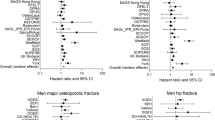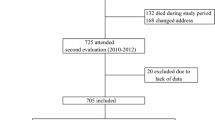Abstract
Summary
There were differences in risk factors between men and women and between two follow-up time lengths. Osteoporosis was significantly associated with recurrent falls for women but not for men. The relationship of osteoporosis with falls in the past year decreased during follow-up, while those of sedatives and hypnotics remained.
Introduction
A prospective study to investigate relationships between osteoporosis and recurrent falls at two follow-up lengths of 6 and 12 months in older men and women.
Methods
In total, 204 men and 447 women who visited an emergency department due to a fall were recruited.
Results
For men, the risk of falling was not significantly associated with osteoporosis at 6 or 12 months. Men with a fall history were 127 and 100 %, respectively, more likely to have a fall at 6 and 12 months than those without. Men who did not use walking aids were 97 % more likely to have a fall at 12 months than those who did. Women with osteoporosis were 246 and 104 %, respectively, more likely to have a fall at 6 and 12 months than those without. Women with a fall history were 129 and 66 %, respectively, more likely to have a fall at 6 and 12 months than those without. Women taking sedatives and hypnotics were 75 and 102 %, respectively, more likely to have a fall at 6 and 12 months than their counterparts. Women with depression were 138 % more likely to have a fall at 6 months and those using walking aids were 59 % more likely to have a fall at 12 months, compared to their counterparts.
Conclusions
Osteoporosis is association with falls for older women but not for older men. Identifying risk factors for recurrent falls in older people may be affected by the follow-up length, as their associations are reduced over time.
Similar content being viewed by others
Abbreviations
- ADLs:
-
Activities of daily living
- BMI:
-
Body mass index
- ED:
-
Emergency department
- OARS:
-
Older Americans Resources and Services
- POAM:
-
Performance-oriented assessment of mobility problems
- SPMSQ:
-
The Short Portable Mental Status Questionnaire
References
Rubenstein LZ (2006) Falls in older people: epidemiology, risk factors and strategies for prevention. Age Ageing 35(S2):ii37–ii41
Tinetti ME, Speechley M, Ginter SF (1988) Risk factors for falls among elderly persons living in the community. N Engl J Med 319:1701–1707
Centers for Disease Control and Prevention (2003) Nonfatal fall-related traumatic brain injury among older adults—California, 1996–1999. MMWR 52:276–278
Fife D, Barancik JI (1985) Northeastern Ohio Trauma Study III: incidence of fractures. Ann Emerg Med 14:244–248
Howland J, Walker PE, Levin WC et al (1993) Fear of falling among community-dwelling elderly. J Aging Health 5:229–243
Graafmans WC, Ooms ME, Hofstee HMA et al (1996) Falls in the elderly: a prospective study of risk factors and risk profiles. Am J Epidemiol 143:1129–1136
Deandrea S, Lucenteforte E, Bravi F et al (2010) Risk factors for falls in community-dwelling older people—a systematic review and meta-analysis. Epidemiology 21:658–668
World Health Organization (2007) WHO global report on falls prevention in older age. WHO, Geneva
Campbell AJ, Robertson MC (2006) Implementation of multifactorial interventions for falls and fracture prevention. Age Ageing 35(S2):ii60–ii64
Launay C, de Decker L, Annweiler C et al (2013) Association of depressive symptoms with recurrent falls: a cross-sectional elderly population based study and a systematic review. J Nutr Heal Aging 17(2):152–157
Donald IP, Bulpitt CJ (1999) The prognosis of falls in elderly people living at home. Age Ageing 28:121–125
Luukinen H, Koski K, Laippala P, Kivela SL (1995) Risk factors for recurrent falls in the elderly in long-term institutional care. Public Health 109:57–65
Cwikel J (1992) Falls among elderly people living at home: medical and social factors in a national sample. Israel J Med Sci 28:446–453
Tinetti ME, Williams CS (1997) Falls, injuries due to falls, and the risk of admission to a nursing home. N Engl J Med 337:1279–1284
Greene E, Cunningham CJ, Eustace A, Kidd N, Clare AW, Lawlor BA (2001) Recurrent falls are associated with increased length of stay in elderly psychiatric inpatients. Int J Geriatr Psychiatry 16:965–968
Yu WY, Hwang HF, Hu MH, Chen CY, Lin MR (2013) Effects of fall injury type and discharge placement on mortality, hospitalization, falls, and ADL changes among older people in Taiwan. Accid Anal Prev 50:887–894
Delbaere K, Crombez G, Vanderstraeten G, Willems T, Cambier D (2004) Fear-related avoidance of activities, falls and physical frailty. A prospective community-based cohort study. Age Ageing 33:368–373
Liu-Ambrose TY, Eng JJ, Khan KM, Carter ND, McKay HA (2003) Older women with osteoporosis have increased postural sway and weaker quadriceps strength than counterparts with normal bone mass: overlooked determinants of fracture risk? J Gerontol 58:M862–M866
Sinaki M, Brey RH, Hughes CA, Larson DR, Kaufman KR (2005) Balance disorder and increased risk of falls in osteoporosis and kyphosis: significance of kyphotic posture and muscle strength. Osteoporos Int 16:1004–1010
Chen X, Nguyen HV, Shen Q, Chan DKY (2011) Characteristics associated with recurrent falls among the elderly within aged-care wards in a tertiary hospital: the effect of cognitive impairment. Arch Gerontol Geriatr 53:e183–e186
Beauchet O, Annweiler C, Allali G et al (2008) Recurrent falls and dual task-related decrease in walking speed: is there a relationship? J Am Geriatr Soc 56:1265–1269
Luukinen H, Koski K, Kivela SL, Laippala P (1996) Social status, life changes, housing conditions, health, functional abilities and life-style as risk factors for recurrent falls among the home-dwelling elderly. Public Health 110:115–118
Pfeiffer E (1975) A short portable mental status questionnaire for the assessment of organic brain deficit in elderly patients. J Am Geriatr Soc 23:433–441
WHO/IASO/IOTF (2000) The Asia-Pacific perspective: redefining obesity and its treatment. Health Communication Australia, Melbourne
Frost ML, Blake GM, Fogelman I (2000) Can the WHO criteria for diagnosing osteoporosis be applied to calcaneal quantitative ultrasound? Osteoporos Int 11:321–330
Liu CK, Tai CT, Lin RT, Chen YF, Lai CL (1996) Validation of Short Portable Mental Status Questionnaire. The 5th Annual Meeting of the Gerontological Society, Taiwan, Republic of China, p 41
Sheikh JA, Yessavage JA (1986) Geriatric Depression Scale (GDS): recent findings and development of a shorter version. In: Brink TL (ed) Clinical gerontology: a guide to assessment and intervention. Haworth, New York
Liao YC, Yeh TL, Ko HC et al (1995) Geriatric Depression Scale—validity and reliability of the Chinese-translated version: a preliminary study. Med J Changhua Christian Hosp (ROC) 1:11–17
Fillenbaum GG, Smyer MA (1981) The development, validity, and reliability of the OARS multidimensional functional assessment questionnaire. J Gerontol 36:428–434
Chiu HC, Chen YC, Mau LW, Shiao SH, Liu HW, Huang MS (1997) An evaluation of the reliability and validity of the Chinese-version OARS multidimensional functional assessment questionnaire. Chin J Public Health (Taipei) 16(2):119–132
Tinetti ME (1986) Performance-oriented assessment of mobility problems in elderly patients. J Am Geriatr Soc 34:119–126
Lamb SW, Jørstad-Stein EC, Hauer K, Becker C (2005) Prevention of Falls Network Europe and Outcomes Consensus Group. Development of a common outcome data set for fall injury prevention trials: the Prevention of Falls Network Europe consensus. J Am Geriatr Soc 53(9):1618–1622
Mickey RM, Greenland S (1989) The impact of confounder selection criteria on effect estimation. Am J Epidemiol 129:125–137
Lynn SG, Sinaki M, Westerlind KC (1997) Balance characteristics of persons with osteoporosis. Arch Phys Med Rehabil 78:273–277
Nguyen AD, Ahlborg HG, Center JR, Eisman JA, Nguyen TV (2007) Residual lifetime risk of fracture in women and men. J Bone Miner Res 22:781–788
Muir SW, Berg K, Chesworth B, Klar N, Speechley M (2010) Quantifying the magnitude of risk for balance impairment on falls in community-dwelling older adults: a systematic review and meta-analysis. J Clin Epidemiol 63:389–406
Collins AJ, Foley RN, Chavers B, et al (2009) United States renal data system 2008 annual data report (abstract). Am J Kidney Dis 53(Suppl):S8–S374
Leipzig RM, Cumming RG, Tinetti ME (1999) Drug and falls in older people: a systemic review and meta-analysis: I. psychotropic drugs. J Am Geriatr Soc 47:30–39
Kelly KD, Pickett W, Yiannakoulia N et al (2003) Medication use and falls in community-dwelling older persons. Age Ageing 32:503–509
Swift CG, Ewen JM, Clarke P, Stevenson IH (1985) Responsiveness to oral diazepam in the elderly: relationship to total and free plasma concentrations. Br J Clin Pharmacol 20:111–118
Bressler R, Bahl JJ (2003) Principles of drug therapy for elderly patients. Mayo Clin Proc 78:1564–1577
Hausdorff JM, Nelson ME, Kaliton D et al (2001) Etiology and modification of gait instability in older adults: a randomized controlled trial of exercise. J Appl Physiol 90:2117–2129
Scaf-Klomp W, Sanderman R, Ormel J, Hempen G (2003) Depression in older people after fall-related injuries: a prospective study. Age Ageing 32:88–94
Szklo M, Nieto FJ (2007) Epidemiology: beyond the basics (2nd edn). Jones and Bartlett, Gaithersburg
Conflicts of interest
None.
Author information
Authors and Affiliations
Corresponding author
Additional information
Presentation: This material has not previously been presented in any form.
Rights and permissions
About this article
Cite this article
Lin, MR., Hwang, HF., Lin, PS. et al. Relations of osteoporosis and follow-up duration to recurrent falls in older men and women. Osteoporos Int 25, 863–871 (2014). https://doi.org/10.1007/s00198-013-2549-5
Received:
Accepted:
Published:
Issue Date:
DOI: https://doi.org/10.1007/s00198-013-2549-5




